This was published 9 months ago
Some locals call this suburb ‘the island’ and it’s on the rise
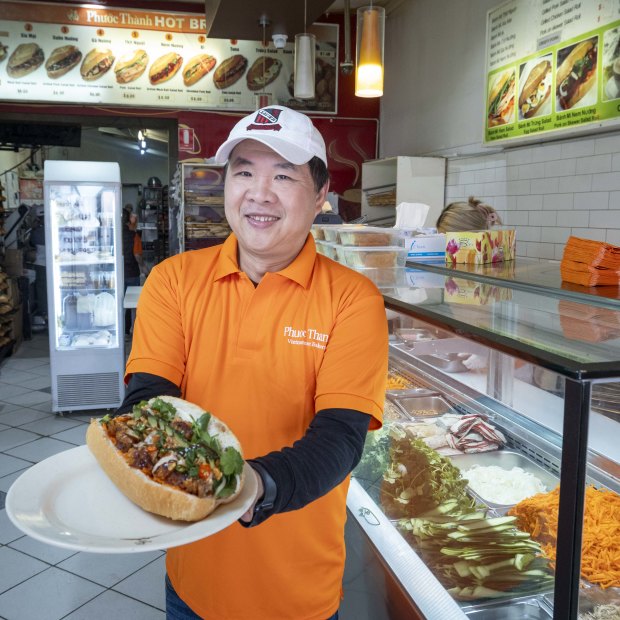
Danny Nguyen is the owner of legendary Victoria Street bakery Phuoc Thanh.Credit: Wayne Taylor
It’s the last Saturday of September and Richmond is alive. A dozen people wait for banh mi at Vietnamese bakery Phuoc Thanh. Young and old wander the 151-year-old Gleadell Street Market, pondering pastries, fresh juice and Tibetan dumplings. Teenage boys play basketball in the sun at Richmond High School and, across Punt Road, a helicopter hovers over the ’G.
Richmond during grand final weekend is the place to be – ask the tens of thousands of people who flocked to Swan Street and Punt Road Oval after the Tigers’ premierships in 2017 and 2019. For this year’s Swans v Lions game, sales at local bars and pubs more than doubled, while spending at restaurants grew 28 per cent, National Australia Bank says.
“Around this time of the year, the whole area is buzzy,” says Carmen Wong, who has worked at the Epworth hospital on Bridge Road for 22 years.
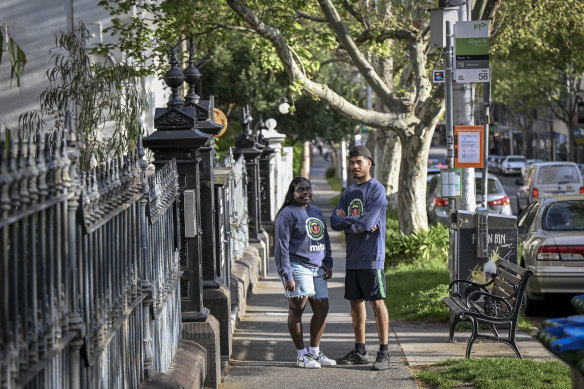
Melbourne Indigenous Transition School captains Pauline Managaygay and Sam Warrior.Credit: Eddie Jim
But Richmond, encompassing Cremorne, North Richmond and Burnley, isn’t always a party place. “If you work on a Friday or Saturday night, or a finals night, it’s really busy everywhere in Richmond. And other times, like a Tuesday night, there’s no one around,” says Wong.
And the suburb, a few clicks east of the city, takes in much more than football. It’s a hub for healthcare, business, public transport and hospitality, with a rich history and young population that is spoilt for food and pubs.
Resident Chris McNeill says many locals call it “the island”, as it has the Yarra River to the north, east and south, and Punt Road providing a barrier to the west.
Local state MP Gabrielle de Vietri says it “feels like almost everyone in metropolitan Melbourne has lived in Richmond at one time”. The Greens MP won the one-time Labor stronghold in 2022, amid resident concerns over the cost of rent and living. Graffiti in a public toilet at Citizens Park still urges residents to “Stop the woke! Stop the Greens! Stop Adam Bandistan!”
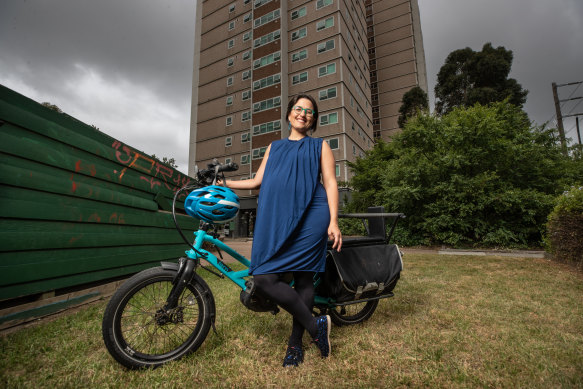
Gabrielle de Vietri in 2022.Credit: Jason South
Indeed, Richmond is rarely far from public debate. There’s the public high-rise towers in Highett Street – a landmark that will soon be demolished under the Allan government’s plans to raze and rebuild them.
De Vietri wants the towers to stay, as she does the suburb’s safe injecting room – the only one in the state. It sits next to Richmond West Primary School and drug-related incidents in its vicinity has been a lightning rod for anger and distress from some residents.
Over the years Richmond has hosted Australia’s first successful balloon flight (in 1858), and has been home to gangsters (“Squizzy” Taylor), singers (Dame Nellie Melba) and the first woman to be elected to a Victorian municipal council (Mary Rogers).
Once an industrial powerhouse, you’ll now find some of the country’s biggest companies there, including REA Group, Mecca, Carsales and Australia Post. Here, rich listers share the streets with the disadvantaged.
The Richmond of today is predominantly young, unmarried, female, highly educated and hard-working. More than half of the residents rent, live in an apartment and are coupled up. In this former Catholic heartland, more than half now say they have no religion.
There aren’t a huge number of kids in Richmond, or elderly people. The largest age group is 25- to 29-year-olds, and the suburb’s median age is 34, well below the state median of 38.
The census data shows almost 53 per cent of residents have a bachelor degree, and 69 per cent work full-time, often as professionals, managers or in hospitals. Close to a quarter work more than 45 hours a week, far more than elsewhere.
Australia is the most common country of birth (at 65.5 per cent), followed by Vietnam (3.9 per cent) and England (3.8 per cent).
Richmond and the broader City of Yarra were once looked after by the Wurundjeri-willam people, of the Wurundjeri-balluk clan.
In 1837 Robert Hoddle, the Port Phillip surveyor general, surveyed the area and described it as a “grassy hill, lightly wooded, with open pasture, stretching down to the river flats and swamps”.
Forty-seven lots were put up for sale, advertised as a “rural retreat for gentlemen”, the Richmond and Burnley Historical Society reports. The higher land closer to the city attracted the wealthy, as the Yarra River became polluted with sewage and industrial waste.
By 1885, Richmond had 52 industrial establishments, including tanneries, breweries, boot factories, coach builders and piano makers.
Bridges, trains and tramways were built, and gas and electricity arrived. At the turn of the 20th century, 40,000 people lived in Richmond.
By the 1950s, Richmond was considered unappealing. “Many of the houses were rundown and the air was marked by the smell of lime, tanneries, tomato sauce, burning malt and the pungency of Horticultural Garden’s tip,” the City of Yarra reports.
In the 1960s and ’70s, industries largely relocated and large numbers of European and Asian migrants arrived.
David Langdon has lived in Richmond all his life, since the ’50s, and now devotes his free Fridays to the Richmond and Burnley Historical Society.
“You’d wake up in the morning and hear the early whistles of factories starting – toot, toot – all over the place,” Langdon says of his early years.
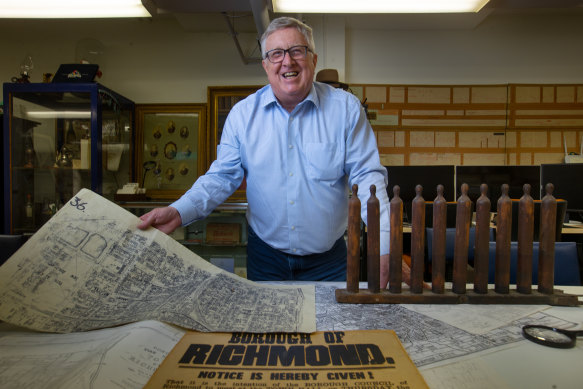
David Langdon, president of the Richmond and Burnley Historical Society, with artefacts.Credit: Simon Schluter
He recalls milk being delivered by horse and cart. Milk bars, butchers and green grocers on corners. Plenty of hotels and churches. Adults being addressed as “Mr” or “Mrs”.
“You could do stuff around the [Yarra] river, hiking – it almost felt like the jungle. You made your own fun by playing in a laneway, kicking a footy or [playing] cricket or going to the swimming pool,” he says.
Langdon’s school photos from the 1960s show children newly arrived from Italy, Greece, Turkey and Egypt. “People came off with language difficulties, there probably wasn’t as much support for people to learn English as nowadays, but the kids got on pretty well,” he says.
“Richmond was a good landing spot because you could get accommodation, and you could get two or three jobs.”
Football was a glue, too. “Once you follow a football team, or you might play footy, no matter where you come from, the football was the leveller for people,” Langdon says. Despite a sorry season, the Tigers still have 98,489 members, 1.7 per cent of whom live in the suburb.
You can’t visit Richmond without tripping over a coffee shop, cafe or restaurant.
Phuoc Thanh is a legendary banh mi spot in North Richmond. Here, the decor is old school, as are the prices – it’s $8 for grilled pork, chicken or tofu rolls.
Owner Danny Nguyen says Victoria Street has lost a lot of foot traffic and tenancies over the years because of crime, but his business remains busy.
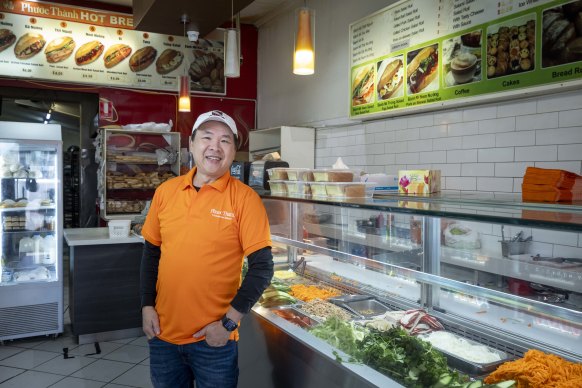
Phuoc Tan Bakery owner Danny Nguyen.Credit: Wayne Taylor
“Because the people know us, that’s why they come in to buy the bread. We’re still busy,” he says.
Phuoc Thanh supplies bread to Vlado’s, a welcoming steakhouse with a menu dating back decades and pictures of its famous guests on the walls.
“You know what the Chinese say? If you stay in one place long enough, the whole world comes past,” says Michael Gregurek, whose father Vlado fled Croatia and founded the restaurant 60 years ago.
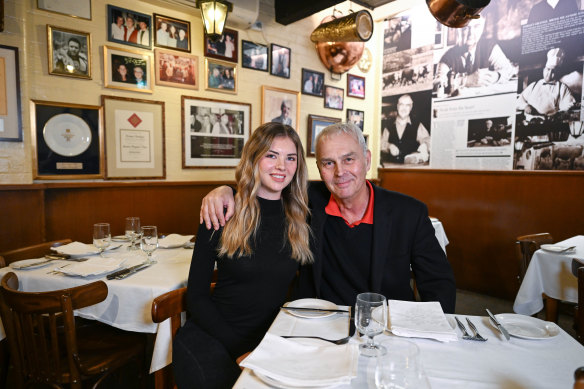
Michael Gregurek of Vlado’s restaurant with his daughter Phoenix, who wants to take over the 60-year-old business.Credit: Joe Armao
Gregurek does everything at Vlado’s from cleaning plates to talking to guests. His 92-year-old mother, Nina, remains company director and a regular patron. Michael’s daughter, Phoenix, hopes to take over eventually.
“A lot of love in this place, so it’s like walking into home every day,” she says. “I really appreciate everything that he’s done, Vlado, and passed on to dad as well.”
Then there Richmond’s pubs, which have hosted some of the world’s best musicians (the Corner Hotel) and Visy and Amcor’s illicit deal to rig prices in the cardboard box market (the All Nations Hotel).
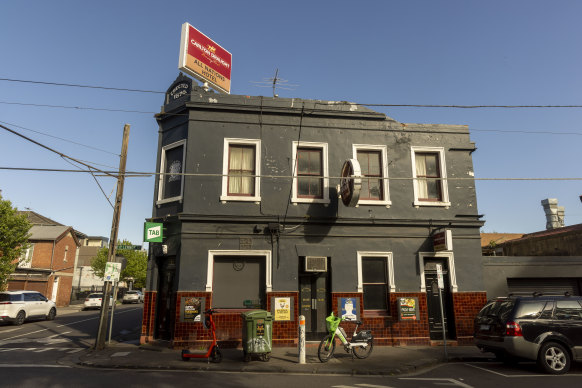
The All Nations Hotel on Lennox Street.Credit: Wayne Taylor
Gina Cimarosti, of the London Tavern Hotel on Lennox Street, says locals fell back in love with pubs during the pandemic lockdowns.
“The local crowd has come back really stronger than before COVID,” Cimarosti says. “And they are the heart of the Tavern.”
Carmen Wong started working at the 104-year-old Epworth hospital in Richmond as a young nurse. Now hospital co-ordinator, she’s seen Epworth Richmond expand in size and capability to become Victoria’s largest private hospital on one site.
The hospital’s emergency department saw more than 29,000 patients in the year to June. “We get a lot of patients with chest pain, we get oncology patients, sepsis patients and slips, trips and falls, cuts, broken bones,” Wong says.
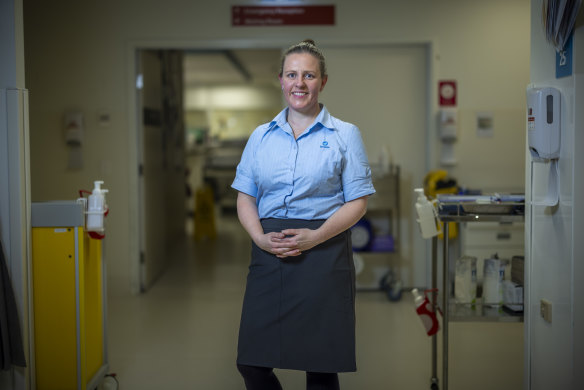
Carmen Wong, hospital Co-ordinator at Epworth Richmond.Credit: Wayne Taylor
Epworth Richmond has more than 2500 employees and 1000 medical specialists. Wong says more health professionals are setting up nearby.
Jeremy Hope, who represents traders on the often-struggling Bridge Road, says health businesses are a growth segment for the 2.5 kilometres of shops between Punt Road and the Yarra.
The next stage is tourism, he says. “When we have major events such as the football, the grand prix, the Australian Open, concerts, Taylor Swift, our hotels fill up and the streets fill up. We’ve got four hotels on the street, the Motley Hotel will be a Hilton Hotel.
“And 20 years from now, it’s going to be apartments above and shops below.”
Not many Richmond residents have babies and toddlers, and those that do usually leave. School-aged kids account for a small percentage of residents.
But real estate agent Julie Taylor says Richmond has great networks for young parents – and the opening of Richmond High School in 2018 has helped families stay.
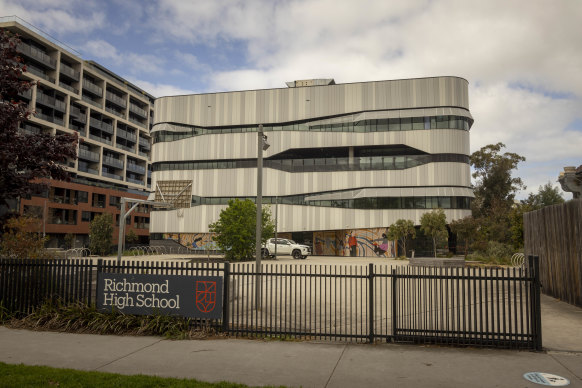
Richmond High School opened in 2018, decades after the local state school was shut by the Kennett government. Credit: Wayne Taylor
Richmond High School is the only state secondary school in Australia that runs a Chinese bilingual program.
The suburb also has to the only registered school in Australia, possibly the world, based out of a professional sporting club.
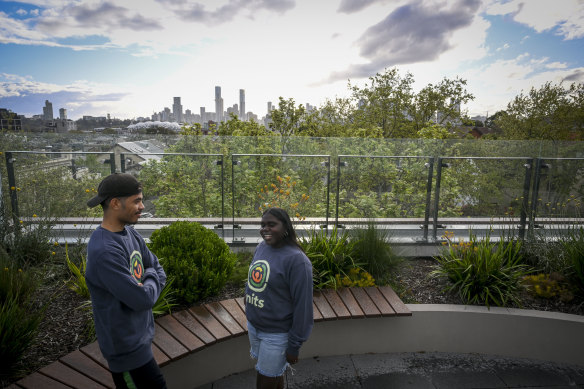
Sam Warrior and Pauline Managaygay are captains of Melbourne Indigenous Transition School in Richmond.Credit: Eddie Jim
The Melbourne Indigenous Transition School is based at Richmond Football Club, but has nothing to do with football, says chief executive Edward Tudor.
MITS is a boarding school for students in years 7 and 8 from rural Victoria and remote Northern Territory. It then helps students transition to other schools.
School co-captain Sam Warrior says it’s tough being so far from home and family, but Richmond is all right.
“It’s safe, I feel like I’m part of the community. I know my way around and a lot of people here,” the year 12 student says.
Fellow co-captain Pauline Managaygay describes it as is a big place with everything.
Three-quarters of Salli Loyd’s mothers’ group have left Richmond, but Lloyd is staying put. She loves having four schools nearby and her electric bike is “very Richmond”.
“I put the two kids on and it’s a godsend. It gets me everywhere. And we see a lot of parents in Richmond with that now,” Lloyd says.
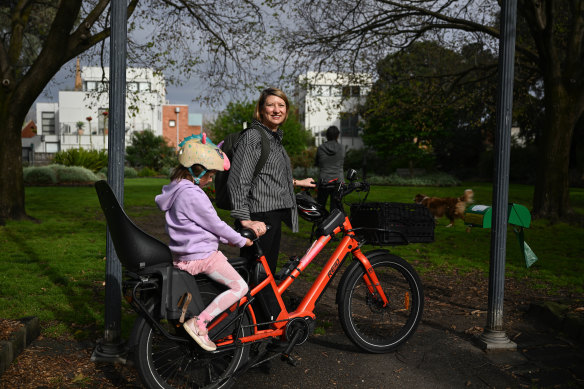
Salli Lloyd on her bike with her daughter Indigo.Credit: Joe Armao
Census data shows only 24.3 per cent of Richmond residents drive to work, while 6.6 per cent walk and 2.5 per cent cycle.
Richmond also has six train stations, the highest number outside the CBD. The persistently grimy Richmond station is Melbourne’s sixth busiest. The suburb also has four tram lines – 75, 70, 109 and 78 – snaking through its streets.
Father of two Chris McNeill says Richmond is a great place to raise kids as families can walk and ride everywhere, and bump into each other when out and about.
He says the suburb’s drawbacks – parking, noise and traffic – are all manageable.
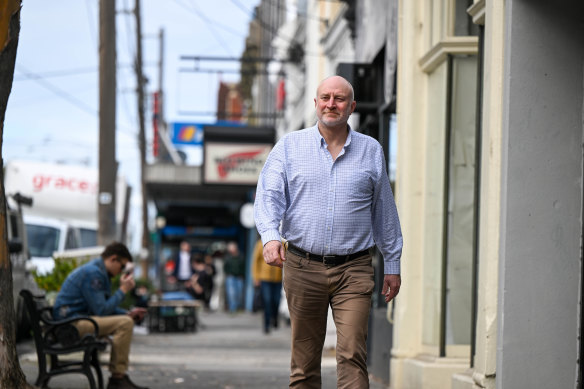
Chris McNeill is a proud resident of Richmond and has raised two children there.Credit: Joe Armao
And unlike many inner-city residents, McNeill enjoys watching more people move in.
“Of the stayers, I’m always struck at how many of us originates from country areas but have made Richmond our home,” he says.
“My theory is that many of us decided that, if we’re going to live in the city, we want to be right in the city.”
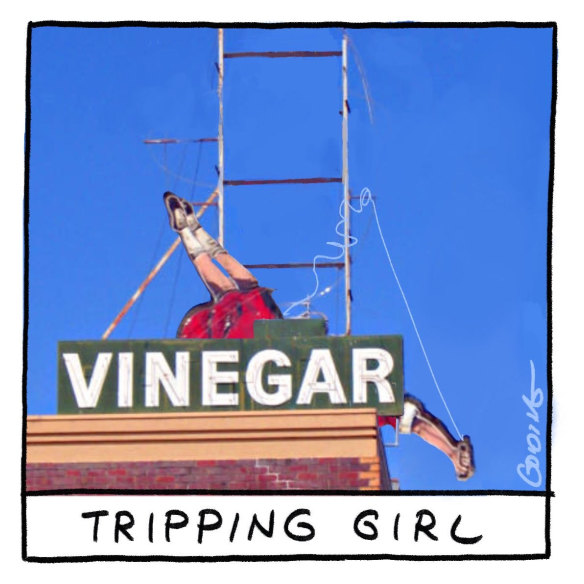
Credit: Matt Golding
Start the day with a summary of the day’s most important and interesting stories, analysis and insights. Sign up for our Morning Edition newsletter.